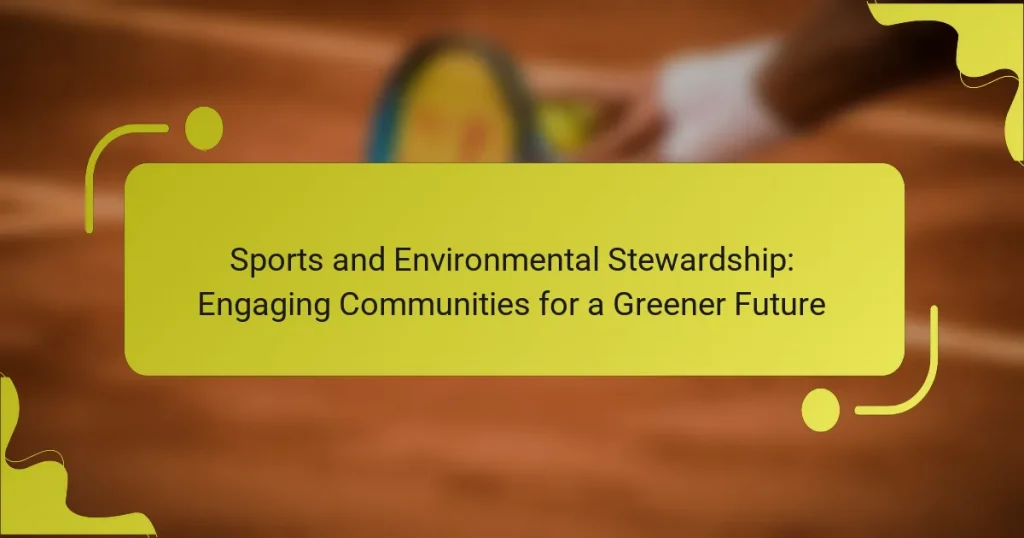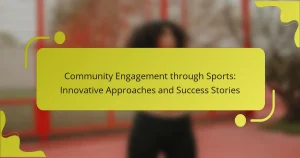Engaging communities in environmental stewardship through sports can lead to a greener future. Sports organisations can implement sustainable practices, collaborate with local groups, and host eco-focused events. Key challenges include funding limitations and lack of awareness. Innovative practices and fan engagement play crucial roles in promoting sustainability metrics, driving positive change in local ecosystems.

How can sports organisations promote environmental stewardship?
Sports organisations can promote environmental stewardship by implementing sustainable practices and engaging their communities. They can reduce waste through recycling programmes and use renewable energy sources at venues. Collaborating with local environmental groups enhances community involvement. Educational campaigns raise awareness about sustainability, encouraging fans to adopt eco-friendly habits.
Moreover, organisations can host events focused on environmental initiatives, such as tree planting or clean-up drives. By integrating sustainability into their operations and outreach, sports organisations can lead the way in fostering a greener future.
What are the benefits of environmental initiatives in sports?
Environmental initiatives in sports provide significant benefits, including enhanced community engagement, improved public health, and increased awareness of sustainability. These initiatives foster a culture of environmental stewardship among athletes and fans, leading to lasting positive changes.
For example, sports organisations that adopt green practices often witness increased participation from local communities, as these efforts resonate with environmentally conscious individuals. Additionally, promoting eco-friendly practices can reduce the carbon footprint of events, contributing to a healthier planet.
Moreover, educational programmes associated with sports initiatives raise awareness about environmental issues, encouraging fans to adopt sustainable practices in their daily lives. As a result, sports become a platform for driving social change and promoting collective responsibility toward the environment.
Which sports leagues are leading in sustainability efforts?
The leading sports leagues in sustainability efforts include the NBA, NFL, MLB, and Premier League. These organisations are implementing initiatives to reduce carbon footprints, enhance recycling programmes, and promote community engagement. For example, the NBA has committed to achieving net-zero carbon emissions by 2030. The NFL has launched a “Green Initiative” focusing on energy efficiency in stadiums. MLB is enhancing waste management practices, while the Premier League supports various environmental charities. These efforts reflect a growing commitment to environmental stewardship within sports.
How do community engagement strategies enhance environmental awareness?
Community engagement strategies significantly enhance environmental awareness by fostering collaboration and promoting sustainable practices. Sports initiatives mobilise community members, creating a shared sense of responsibility toward the environment.
Engaging local athletes as ambassadors can amplify awareness through their influence. Events like clean-up drives or tree-planting activities encourage participation and educate attendees on environmental issues. Research indicates that communities involved in sports-related environmental programmes report increased knowledge and commitment to sustainability.
Furthermore, partnerships with local organisations can provide resources and expertise, enhancing the effectiveness of these initiatives. By integrating environmental education into sports programmes, communities can cultivate a culture of stewardship that benefits both people and the planet.
What role do athletes play in advocating for sustainability?
Athletes play a crucial role in advocating for sustainability by using their platforms to raise awareness. They influence fans and communities to adopt eco-friendly practices. Many athletes engage in initiatives focused on reducing waste, promoting renewable energy, and supporting conservation efforts. Their visibility can drive significant changes in public attitudes toward environmental issues. For example, athletes participating in campaigns can lead to increased support for sustainable policies and practices within their sports organisations and beyond.
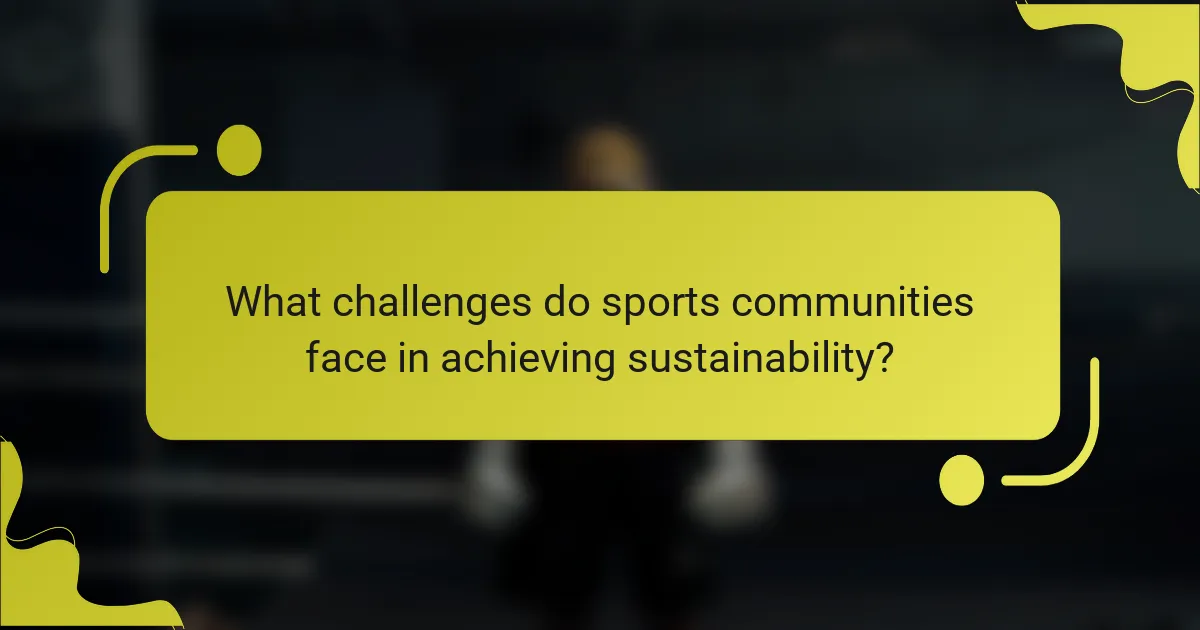
What challenges do sports communities face in achieving sustainability?
Sports communities face several challenges in achieving sustainability, including funding limitations, lack of awareness, and infrastructure constraints. Many sports organisations struggle to secure financial resources for green initiatives. Additionally, insufficient knowledge about sustainable practices hampers community engagement. Infrastructure limitations, such as inadequate recycling facilities at venues, further complicate efforts. These factors collectively hinder the transition to environmentally friendly practices within sports communities.
How can funding and resources be effectively allocated for green initiatives?
Effective allocation of funding and resources for green initiatives requires strategic planning and community engagement. Prioritise projects that demonstrate clear environmental benefits and community support. Utilise partnerships with local organisations to enhance resource sharing and outreach. Implement transparent budgeting processes to ensure accountability and attract additional funding sources. Monitor and evaluate project outcomes to refine future allocations and maximise impact.
What are common misconceptions about environmental efforts in sports?
Common misconceptions about environmental efforts in sports include the belief that they are merely superficial or token gestures. Many assume that these initiatives lack genuine impact or commitment. However, numerous sports organisations actively implement sustainable practices, such as reducing waste and promoting eco-friendly materials. Engaging communities effectively enhances awareness and participation in these efforts, fostering a deeper connection to environmental stewardship. Another misconception is that environmental initiatives are too costly; in reality, they often lead to long-term savings and improved brand loyalty.

Which innovative practices are emerging in sports for environmental stewardship?
Innovative practices in sports for environmental stewardship include sustainable facility design, waste reduction initiatives, and community engagement programmes. Sports organisations increasingly adopt renewable energy sources and promote eco-friendly transportation options. For example, stadiums are integrating solar panels and green roofs, enhancing their energy efficiency. These practices foster community involvement and raise awareness about environmental issues, contributing to a greener future.
How can technology enhance sustainability in sporting events?
Technology can significantly enhance sustainability in sporting events by optimising resource use and reducing waste. Smart technologies, such as energy-efficient lighting and waste management systems, minimise environmental impact. For example, real-time data analytics can track energy consumption and water usage, leading to more informed decisions. Additionally, digital ticketing reduces paper waste and enhances attendee experience. Innovations like solar-powered stadiums showcase renewable energy use, promoting a greener image for sports organisations. These advancements engage communities and foster a collective commitment to environmental stewardship.
What are the unique initiatives from local sports clubs making a difference?
Local sports clubs are implementing unique initiatives that promote environmental stewardship and engage communities. These initiatives include organising clean-up events, creating community gardens, and promoting sustainable practices among members. For example, some clubs have adopted recycling programmes and partnered with local environmental organisations to host educational workshops. These efforts not only enhance community involvement but also contribute to a greener future.

How does fan engagement influence environmental practices in sports?
Fan engagement significantly influences environmental practices in sports by fostering community involvement and awareness. Engaged fans advocate for sustainable initiatives, encouraging teams to adopt greener practices. For instance, teams that prioritise fan input often implement recycling programmes, reduce waste, and promote eco-friendly transportation options. As a result, sports organisations can enhance their environmental stewardship and create a positive impact on local ecosystems. Engaged fans not only support these initiatives but also hold teams accountable, driving a culture of sustainability within the sports industry.
What strategies can teams use to educate fans on sustainability?
Teams can educate fans on sustainability through interactive programmes, community events, and digital campaigns. Engaging fans with hands-on experiences fosters a deeper understanding of environmental issues. For example, organising clean-up days at local parks allows fans to contribute directly to their communities. Utilising social media platforms to share tips and success stories can amplify awareness. Collaborating with local environmental organisations enhances credibility and outreach. Providing incentives for sustainable behaviours, such as discounts for using public transport to games, encourages fan participation.
How do fan behaviours impact environmental outcomes at events?
Fan behaviours significantly influence environmental outcomes at events by promoting sustainable practices. Engaged fans can reduce waste through recycling initiatives and support eco-friendly transportation options. Their participation in sustainability programmes can lead to a decrease in carbon footprints associated with events. For instance, events that encourage fans to carpool or use public transport often see a reduction in emissions. Additionally, fans advocating for green initiatives can drive organisations to adopt more sustainable policies, enhancing overall environmental stewardship within the sports community.

What metrics are used to measure the success of environmental initiatives in sports?
Key metrics used to measure the success of environmental initiatives in sports include carbon footprint reduction, waste management efficiency, water conservation rates, and community engagement levels. These metrics help assess the overall impact and effectiveness of sustainability efforts in the sports sector.
| Metric | Description | Value Example |
|—————————-|————————————————–|——————————|
| Carbon Footprint Reduction | Measurement of greenhouse gas emissions saved | 30% reduction over 5 years |
| Waste Management Efficiency | Ratio of waste recycled versus total waste | 75% recycling rate |
| Water Conservation Rates | Reduction in water usage during events | 40% decrease in usage |
| Community Engagement Levels | Number of community programmes initiated | 10 new programmes each year |
Which benchmarks are most effective in evaluating sustainability efforts?
Effective benchmarks for evaluating sustainability efforts in sports include carbon footprint assessments, waste reduction metrics, and community engagement indices. These benchmarks help organisations measure their environmental impact and community involvement.
1. Carbon Footprint Assessments | Measure greenhouse gas emissions from events and operations.
2. Waste Reduction Metrics | Track the amount of waste diverted from landfills through recycling and composting.
3. Water Usage Efficiency | Evaluate the reduction in water consumption across facilities.
4. Sustainable Transportation Initiatives | Assess the percentage of attendees using public transport or carpooling.
5. Community Engagement Indices | Measure participation in sustainability programmes and local environmental initiatives.
6. Energy Efficiency Ratings | Monitor energy consumption and the transition to renewable energy sources.
How can data analytics improve environmental decision-making in sports?
Data analytics enhances environmental decision-making in sports by providing actionable insights. It enables organisations to track resource consumption, assess environmental impacts, and optimise sustainability initiatives. For example, analytics can identify patterns in energy use during events, leading to reduced carbon footprints. Additionally, data-driven strategies foster community engagement, promoting greener practices among fans and stakeholders. As a result, sports entities can align their operations with environmental goals, creating a positive impact on local ecosystems.
What are the best practices for reporting sustainability outcomes?
The best practices for reporting sustainability outcomes include transparency, stakeholder engagement, and measurable metrics. Organisations should clearly communicate their sustainability goals and progress to build trust. Engaging local communities fosters collaboration and enhances accountability. Utilising specific metrics, such as carbon footprint reduction or waste diversion rates, ensures that outcomes are quantifiable and actionable.
What common mistakes should organisations avoid in their sustainability journey?
Organisations should avoid common mistakes like lack of stakeholder engagement, insufficient goal setting, and ignoring local contexts in their sustainability journey. Engaging communities is vital for successful environmental stewardship.
1. Failing to engage stakeholders limits support and resource sharing.
2. Setting vague or unrealistic goals leads to confusion and disengagement.
3. Neglecting local environmental issues may result in ineffective initiatives.
4. Overlooking communication can hinder transparency and trust.
5. Ignoring data and metrics prevents informed decision-making.
6. Not adapting to feedback stifles innovation and improvement.
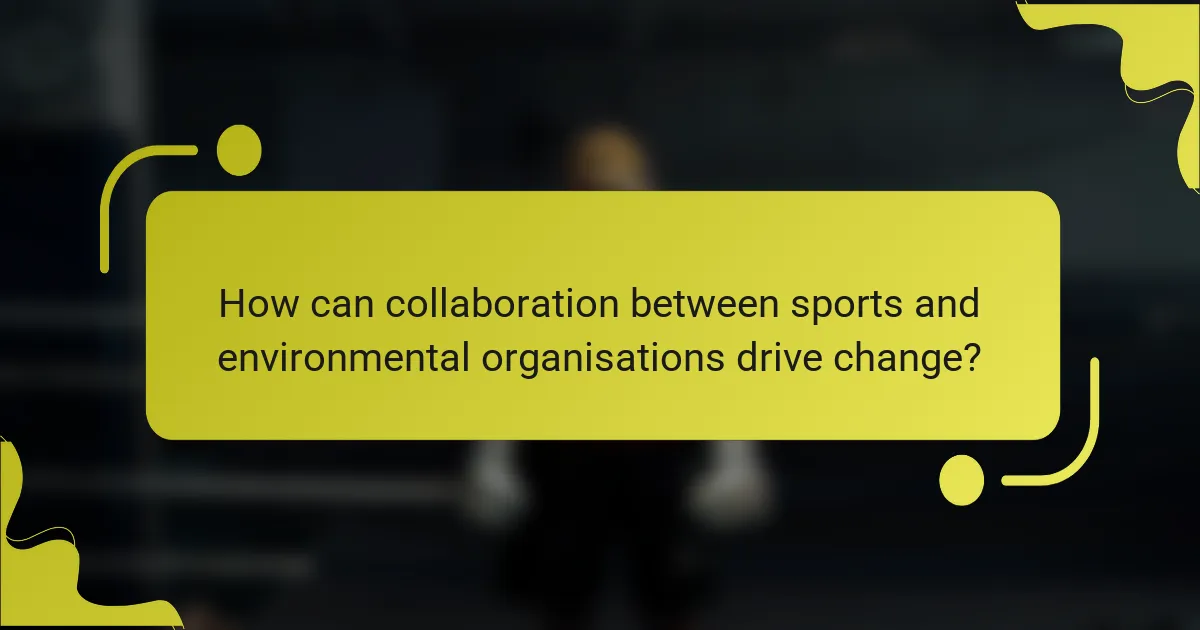
How can collaboration between sports and environmental organisations drive change?
Collaboration between sports and environmental organisations can significantly drive change by leveraging shared goals. Sports entities can promote sustainability through eco-friendly practices, while environmental groups can enhance community engagement via sports events.
For instance, initiatives like green sports venues reduce carbon footprints, and awareness campaigns during major sporting events educate fans on environmental issues. Research indicates that 71% of sports fans support sustainability efforts, highlighting a strong public interest.
Moreover, partnerships can lead to innovative solutions, such as using sports platforms to advocate for conservation efforts. This synergy not only fosters community involvement but also amplifies the impact of environmental initiatives.
What partnerships have proven effective in promoting sustainability in sports?
Collaborations between sports organisations and environmental groups have effectively promoted sustainability. Notable partnerships include the NFL’s Green Initiative, which reduces waste at events, and FIFA’s commitment to sustainable stadiums. These collaborations engage communities and raise awareness about environmental stewardship in sports.
How can cross-sector collaboration enhance community engagement?
Cross-sector collaboration enhances community engagement by leveraging diverse resources and expertise. It fosters shared goals, creating a unified approach to environmental stewardship through sports initiatives. Engaging local athletes and organisations promotes sustainable practices, increasing community participation and awareness. For instance, sports events can incorporate eco-friendly practices, motivating attendees to adopt greener habits. This synergy amplifies impact, leading to a more significant collective effort towards a sustainable future.
What lessons can be learned from successful global initiatives?
Successful global initiatives demonstrate that community engagement in sports can significantly enhance environmental stewardship. These initiatives teach the importance of collaboration, education, and local involvement in promoting sustainability. For example, community sports programmes that incorporate environmental education foster a sense of responsibility among participants. As a result, these programmes can lead to increased awareness and action towards greener practices. Additionally, successful initiatives often leverage local resources and cultural values, making them more relatable and effective in driving change.
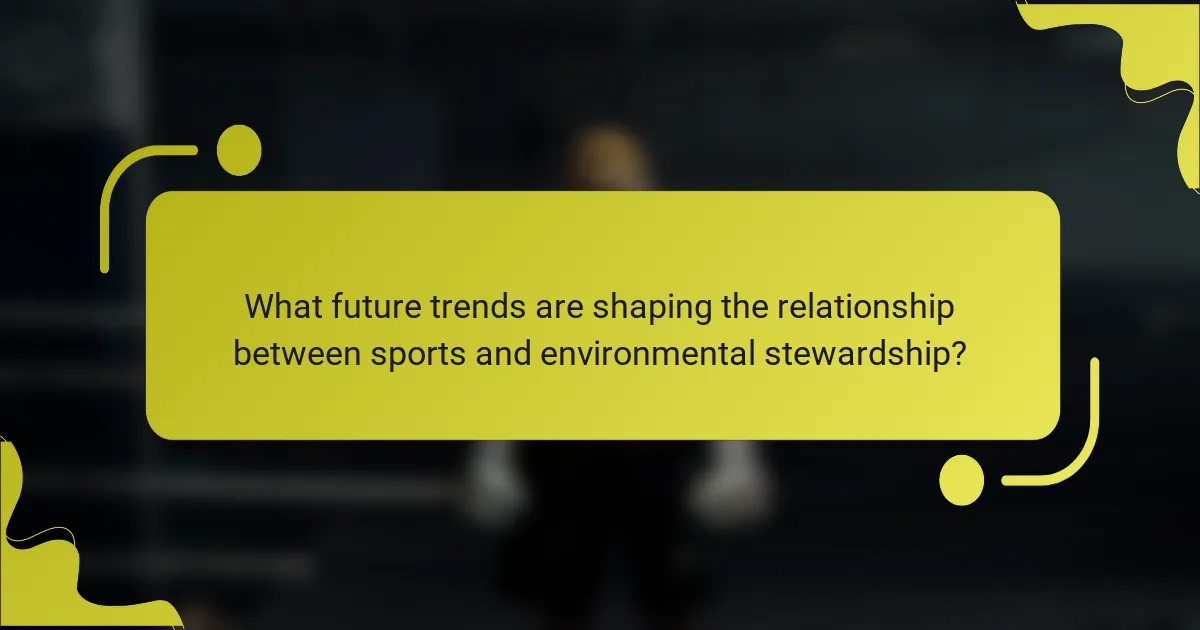
What future trends are shaping the relationship between sports and environmental stewardship?
Future trends are increasingly aligning sports with environmental stewardship, promoting sustainability. Sports organisations are adopting eco-friendly practices, such as reducing carbon footprints and using sustainable materials. For instance, major events like the Olympics are implementing green initiatives, including renewable energy sources and waste reduction strategies.
Community engagement is vital; sports teams are encouraging local participation in environmental projects. This fosters a sense of responsibility and awareness among fans. Collaborations between sports entities and environmental organisations are becoming common, amplifying the impact of sustainability efforts.
Technological advancements also play a role in this relationship. Innovations in materials science lead to the creation of sustainable sports equipment, reducing environmental impact. Furthermore, digital platforms facilitate awareness campaigns, connecting sports fans with environmental causes.
As a result, the future of sports is not just about competition; it involves a commitment to a greener planet, shaping a culture of environmental stewardship across communities.
How are youth sports programmes integrating sustainability into their operations?
Youth sports programmes are increasingly integrating sustainability by adopting eco-friendly practices and promoting environmental awareness. Many organisations are implementing recycling initiatives, using sustainable materials for uniforms and equipment, and encouraging carpooling to reduce carbon footprints.
For example, some programmes are establishing community gardens to teach children about food sustainability and healthy eating. Others are incorporating environmental education into their training sessions, emphasising the importance of conservation and stewardship.
These efforts not only reduce environmental impact but also engage youth in meaningful community involvement, fostering a sense of responsibility towards the planet. As a result, young athletes are becoming advocates for sustainability, influencing their families and peers.
What role will climate change play in shaping sports strategies?
Climate change will significantly influence sports strategies by promoting sustainability and community engagement. Sports organisations are increasingly adopting eco-friendly practices to reduce their carbon footprint. For instance, many teams are investing in renewable energy, minimising waste, and advocating for environmental awareness.
As a result, sports events are becoming platforms for raising awareness about climate issues. Initiatives like tree planting and recycling programmes during major events engage fans and the local community. This approach not only enhances the event experience but also fosters a sense of responsibility towards the environment.
Moreover, climate change will affect scheduling and location decisions for events. Increased temperatures and extreme weather patterns may lead to rescheduling or relocating events to ensure participant safety.
In summary, climate change is reshaping sports strategies by integrating sustainability, enhancing community involvement, and influencing logistical decisions.
How can sports organisations adapt to evolving environmental regulations?
Sports organisations can adapt to evolving environmental regulations by implementing sustainable practices and engaging with their communities. They should prioritise reducing carbon footprints through energy-efficient facilities and waste management initiatives. Collaborating with local governments and environmental groups can enhance compliance and foster community support. Additionally, educating fans on sustainability can promote a culture of environmental stewardship.
What are the emerging technologies that will influence sustainable practices in sports?
Emerging technologies significantly influence sustainable practices in sports by enhancing efficiency and reducing environmental impact. Innovations such as smart stadiums utilise IoT to optimise energy consumption. Renewable energy sources, like solar panels, power facilities and reduce carbon footprints. Advanced materials for sports equipment minimise waste and enhance recyclability. Data analytics helps organisations track sustainability metrics effectively. Lastly, virtual reality promotes eco-conscious training and fan engagement by reducing travel needs.
What expert tips can help sports organisations enhance their environmental initiatives?
Sports organisations can enhance their environmental initiatives by adopting sustainable practices, engaging communities, and leveraging technology. Focus on reducing waste through recycling programmes and promoting eco-friendly transportation options. Collaborate with local organisations to raise awareness and create green campaigns. Utilise data analytics to track environmental impact and improve strategies.
